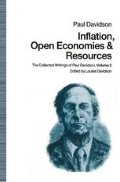Abstract
It has been argued by a number of economists that the recent poor performance of the United States economy is due to a policy bias against saving by the private sector of the economy. Government policy, it is claimed, which taxes income and capital gains while distributing social welfare benefits, discourages private saving and therefore leads to economic stagnation. Unfortunately, this argument confuses the role of private saving with the role played by finance in a modern, capitalist, market-oriented production economy. If the United States has been hobbled on the ‘supply side’ in recent years, it is because of a shortage of finance and not because of a shortage of saving. In point of fact, to the extent that government policy did directly inhibit the private sector’s tendency to save out of income during the 1970s, the greater has been the actual growth of GNP.
Special Study on Economic Change. Vol. 4 Stagflation: The Causes, Effects and Solutions (Washington: Joint Economic Committee, 1980).
Access this chapter
Tax calculation will be finalised at checkout
Purchases are for personal use only
Preview
Unable to display preview. Download preview PDF.
References
Arrow, K. J. and F. H. Hahn (1971) General Competitive Analysis, (San Francisco: Holden-Day).
Berle, A. A. and G. C. Means (1934) The Modern Corporation and Private Property, (New York: Macmillan).
Brechling, F. P. R. (1957) ‘A Note on Bond-Holding and the Liquidity Preference Theory of Interest’, Review of Economic Studies, 24.
Business Week Editors (1978) ‘The US Bias Against Savings Leads to High Inflation, Weak Dollar, Slow Growth, Declining Productivity’, Business Week, (December).
Davidson, P. (1960) ‘Rolph on the Aggregate Effect of a General Excise Tax’, Southern Economic Journal, 27.
Davidson, P. (1977) ‘Money and General Equilibrium’, Economie Appliquée, 30.
Davidson, P. (1978) Money and the Real World, (London: Macmillan) 2nd edn.
The Economic Staff (1979) ‘Motoring in the 1980s — A Survey’, The Economist, (10–16 March).
Friedman, M. (1957) The Theory of Permanent Income, (Princeton: Princeton University Press).
Friedman, M. et al., (1974) Milton Friedman’s Monetary Framework: A Debate With His Critics, (Chicago: University of Chicago Press).
Galbraith, J. K. (1958) The Affluent Society, (Boston: Houghton Mifflin).
Galbraith, J. K. (1967) The New Industrial State, (Boston: Houghton Mifflin).
Galbraith, J. K. (1978) ‘On Post Keynesian Economics’, Journal of Post Keynesian Economics, 1.
Harrod, R. F. (1951) The Life of John Maynard Keynes, (London: Macmillan).
Hawtrey, R. G. (1932) The Art of Central Banking, (London: Longmans, Green).
Hicks, J. R. (1967) Critical Essays in Monetary Theory, (Oxford: Clarendon Press).
Kahn, R. F. (1952) ‘Some Notes on Liquidity Preference’, Manchester School.
Keynes, J. M. (1930a) A Treatise on Money, vol. I (London: Macmillan).
Keynes, J. M. (1930b) A Treatise on Money, vol. II (London: Macmillan).
Keynes, J. M. (1936) The General Theory of Employment, Interest and Money, (New York: Harcourt Brace).
Keynes, J. M. (1973) The Collected Works of John Maynard Keynes, vol. XIV (London: Macmillan).
Securities Exchange Commission (1963), Report of Special Study of Securities Markets of the Securities Exchange Commission, Part II (Washington: US Government Printing Office).
Smith, A. (1937) The Wealth of Nations, (New York: Modern Library Edition).
Editor information
Copyright information
© 1991 Paul Davidson
About this chapter
Cite this chapter
Davidson, P. (1991). Is There a Shortage of Savings in the United States? The Role of Financial Institutions, Monetary and Fiscal Policy in Capital Accumulation During Periods of Stagflation. In: Davidson, L. (eds) Inflation, Open Economies and Resources. Palgrave Macmillan, London. https://doi.org/10.1007/978-1-349-11516-7_5
Download citation
DOI: https://doi.org/10.1007/978-1-349-11516-7_5
Publisher Name: Palgrave Macmillan, London
Print ISBN: 978-1-349-11518-1
Online ISBN: 978-1-349-11516-7
eBook Packages: Palgrave Economics & Finance CollectionEconomics and Finance (R0)

